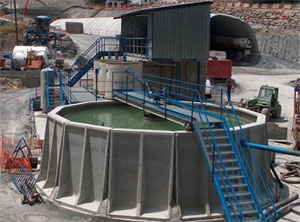Bracons Tunnel
Description of the Environmental Measure
Problem detected:
During the boring of the tunnel, a large amount of effluents was produced with high levels of pH and turbidity that required treatment.
During the first two months of boring, the system adopted to treat the effluents was not entirely effective since it was seen that the turbidity in the water was persistent. This was mainly due to a large amount of suspended solids in it and to the low specific weight of these solids which made decanting very slow. On the other hand, the drilling of blast holes and for bolts and the manufacture and spraying of concrete required a supply of large amounts of water.
Solutions adopted:
The solution finally applied consisted of a system to correct the pH, flocculation and coagulation, a decanter and a press filter to dry and collect the sludge. The clarified water obtained in this way is suitable for re-use in the drilling system or for tipping to the public domain.
The first phase corrected the pH of the drilling water and any filtrations in the tunnel with CO2 diffusion in the water mass.
This was followed by the coagulation and flocculation phase and finally the water was clarified with a prefabricated decanter 8 m in diameter. The decanted mud was treated with an automatically opening and closing press filter equipped with 40 plates measuring 80 x 80.
Results:
The sludge drying systems and the use of flocculants were very effective to achieve the decanting of the suspended solids in the effluents and the neutralisation of the pH on the basis of CO2, an experience that has been repeated in many excavations since it is an optimal solution for high pH levels in waste water.
The press filter dries the mud by 78 per cent, thus providing type 1 material suitable for tipping and the clarified water from the decanter is suitable for re-use in the drilling system or for tipping to the public domain.









